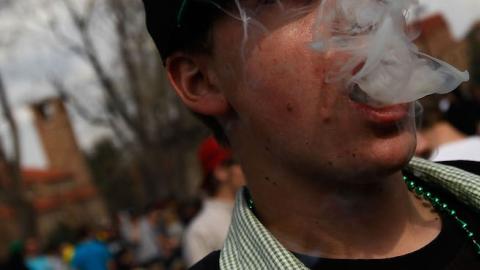In January of 2014, the state of Colorado began implementing the commercial, recreational sale and legal use of marijuana. It is supposed to be restricted to those 21 and older, but abundant evidence shows that Colorado school-age youth are being affected by the availability of marijuana, and the new social norms of acceptance.
The Rocky Mountain High Intensity Drug Trafficking Area (RMHIDTA), a multi-agency law enforcement intelligence fusion center headquartered in Denver, has been tracking the consequences of legalized marijuana on Colorado and its schools. In their most recent government report, they capture observations offered by numerous school counselors in the Denver-area concerning marijuana’s harmful effects on students and schools. The statements should alarm any parent, or indeed anyone working with, or planning on hiring, Colorado youth.
Tetrahydrocannabinol (THC) is the intoxicating chemical found in marijuana. The harmful health effects of THC on the adolescent brain are now established and well-known by scientists and health professionals. The impact is adverse for cognition, memory, learning, IQ, school performance, and psychological health.
**Colorado youth are particularly at risk because of the rising THC potency of the marijuana now being produced and sold in the state. National THC potency has risen from an average of 3.9 percent in 1995 to an average of 12.6 percent in 2013. But the average potency in Colorado was even higher at 17.1 percent.**
Youth in Colorado consume this high-potency drug by smoking, by “vaporizing” so as to hide the activity in the classroom, or by consuming candies, brownies, and drinks containing the active component, THC. So widespread is the practice of youth consuming marijuana edibles, that some schools in Colorado no longer allow students to bring food from home.
+From the Report: Some Comments from School Counselors+
The following words of school counselors, who are at the front lines of this public health crisis and see its negative effect on not only the individual students using, but the learning environment as a whole, should give any state considering marijuana legalization great pause.
Halls Reek of Pot After Lunch:
* “Many kids come back from lunch highly intoxicated from marijuana use. Halls reek of pot, so many kids are high that it is impossible to apprehend all but the most impaired.”
* “They go off campus and smoke during lunch with friends. They will run home with friends during lunch and smoke then.”
* “There have been several instances of students in their cars on lunch or during their off hours ‘hotboxing’ or smoking marijuana. Most students are seniors but on occasion, seniors will provide marijuana to 9th or 10th grade students.”
* “2014/2015 school year, several students caught coming back from off-campus lunch under the influence of marijuana.”
* “More and more students are coming back to school high after lunch.”
Arrives at School Stoned:
* “At the beginning of the second semester, three middle school boys were routinely arriving late at school, and noticeable intoxicated.”
* “We have middle school students who either come to school high, or have it on them in a bag. Or they have pipes on them.”
* “Teaching a lesson in class during first period that started 7:30 AM and 2 students were already high in class.”
* “12 yr. old, sixth grader, was suspected of coming to summer school high. When confronted he told the teacher that he smoked it at home the night before but denied being high at the time. Later, he confirmed that he had smoked early that morning. The marijuana came from his mother’s stash.”
New Use of Bathrooms:
* “Students using in the bathroom.”
* “2 students were smoking marijuana in the restroom last year.”
* “8th grade male student had marijuana in his locker, classmates reported it. 8th grade female student smoked a joint in a school bathroom during school hours. Shared it with a friend.”
* “7th grade girl last year had hidden marijuana and a pipe in the girl’s restroom and told several friends who began getting bathroom break passes from various classrooms.
It’s Legal:
* “3 or 4 times in the last school year, students have come to school under the influence after meeting at homes where parents were absent, sharing marijuana off campus and then bringing it on campus. 7th and 8th grade students have been involved, and most often their reaction when caught is ‘it’s legal’.”
* “I met with at least 5 students last year alone that have been showing significant signs of drug use or were caught and they all said they will not stop using weed on a daily basis. Their justification was it’s fine because it’s legal. If it’s legal it’s not as bad as what adults say about the risks.”
Just a Plant:
* “In March of 2015 a fifth grade boy offered marijuana to another fifth grader on the playground. In October of 2014 a kindergarten girl described the pipe in her grandmother’s car and the store where you go to buy pipes. In May of 2015 a first grade girl reported that her mom smokes weed in the garage. ‘It’s not a drug, it’s just a plant.’”
Grades Decline:
* “Last year I had two very intelligent students (above 4.0) that used marijuana 2-6 times a week. Both of them had grades decline and significant social emotional issues spike in the Spring of their Senior Year. They also both had violations at school.”
Dad Allows Pot Smoking:
* “We had reports of two students (brothers) appear to be high at school. Our officer assessed both of them and discovered that their father, who had a medical marijuana card, was having them both ‘smoke a bowl’ before school. He thought it would make their school day easier.”
Difficulty in Assessment:
* “For school personnel, it is more difficult to evaluate what substance a student is under the influence of. We can smell alcohol and smoked marijuana but the edibles and vapes are hard to detect.”
For parents planning on moving to Colorado, these reports should provide good grounds for reconsidering the risk the school environment there creates for their children.
On the other hand, staying away from Colorado schools may not be enough, as Colorado may be exporting this public health threat and the misguided thinking behind it to other parts of the nation. Interstate smuggling of Colorado marijuana is now becoming a national emergency, and multiple states are now considering adopting Colorado’s legal marijuana policies in the upcoming elections.














